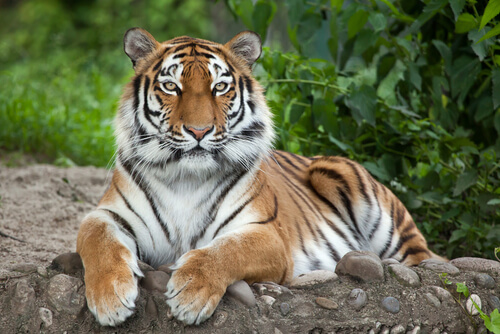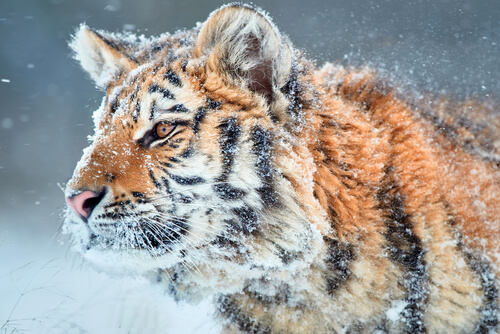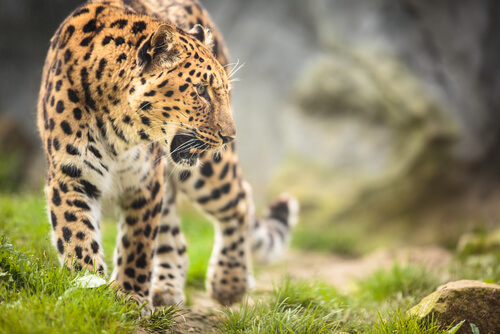
| Kingdom | Animalia |
| Phylum | Chordata |
| Class | Mammalia |
| Order | Carnivora |
| Family | Felidae |
| Genus | Panthera |
| Species | P. tigris |
| Subpecies | P. t. tigris |
| Niche | Apex predator |
| Length | 60 in (150 cm) |
| Weight | 220-675 lbs (100-306 kg) |
| Lifespan | 16-18 years |
| Social Structure | Solitary |
| Conservation Status | Endangered |
| Preferred Habitat | Mountainous forests |
| Average Litter Size | 2-6 |
| Main Prey Species | Deer, boar, badgers, rabbits |
| Predators | Humans |
The Basics
The Siberian tiger (Panthera tigris tigris) is a specific subspecies of tiger (P. tigris) native to far eastern Russia, China, and North Korea. Genetically, it is closest to the extinct Caspian tiger of Central and Western Asia.
Their thick, coarse fur is a red-rust or rust-yellow color, with notorious transverse stripes across the body. Their ground coat is often pale in comparison with other tiger species, and changes between seasons and populations. It has an extended body and relatively short, strong legs and a long tail. Siberian tigers can reach up to 60 inches (150 cm) long and as heavy as 675 lbs (306 kg). However, larger individuals were historically targeted by hunters and most remaining tigers fall short of this, with females weighing at least 220 lbs (100 kg).

Tigers are generally solitary animals. They range over large areas scent-marking it to claim it a part of their territory. They will aggressively defend this territory and hunt any prey that falls within it. This may include large mammals such as deer and boar or the young of even larger animals. They will also eat smaller animals like rabbits and badgers as available. After tracking their prey, they rely on their stealth and camouflage to ambush it.
After a 3-month pregnancy, females typically give birth to litters of two to six cubs which they raise with little involvement from male tigers. Cubs are unable to hunt until at least 18 months of age and will remain with their mothers for two to three years before seeking their own territory. In some cases, female tigers will tolerate their female offspring sharing part of their territory with them as adults.
Current and Historic Range
Historically, Siberian tigers ranged further through the Korean Peninsula as well as northern China and Mongolia. In fact, it is also called the “Amur tiger”, “Manchurian tiger”, “Korean tiger” and “Ussurian tiger” depending on the region in which it is was observed. The remaining population inhabits a mountainous area in southwest Primorye Province of Russia, a part of Siberia, hence “Siberian tiger”.
In 2005, only about 350 Siberian tigers remained in the wild. Due to intensive conservation efforts, populations have remained stable since even increasing to perhaps about 550 individuals in 2014. However, habitat loss and illegal poaching continue to threaten their viability, and they remain listed as “Endangered” by the IUCN.

Fun Facts about Siberian Tiger!
Tigers are one of the most famous animals in the world. They are mysterious, elusive, beautiful, and dangerous. Despite this, of just 9 tiger subspecies, 3 have gone extinct in the 20th century and even more, are on their way to a similar fate. Clearly, we are failing to keep them safe despite our collective awareness of their extraordinary nature and their ability to capture our imaginations.

The Great Traveler
The results of a genetic study concluded that Caspian tigers and Siberian tigers had a common ancestor that ‘traveled’ from Eastern China via the Gansu-Silk Road corridor, colonizing Central Asia and, ultimately, across Siberia.
In fact, modern Siberian tigers are known to travel great distances. Although their range is now limited, it seems they will make use of most of it, traveling up to 1000 km in search of prey or mates. Some records of Siberian tigers have shown that they will travel up to 60 km per day. With this in mind, it is clear why tiger conservation depends greatly on the conservation of large tracts of undisturbed wilderness.
Rare Neighbors
Another rare large feline lives in this region. Generally, tigers spend their time at lower elevations than leopards. But the Amur leopard’s habitat overlaps with Siberian tigers in the Changbai Mountains. Along with Siberian tigers, this is one of the most elusive large cats in the world. In fact, it is listed as critically endangered by the IUCN.

Not a Man-eater
Although often seen as a dangerous threat, tigers are actually very elusive and prefer to avoid humans at all costs. In some cases where tigers do become aggressive towards humans, it is usually due to them being ill or injured and therefore unable to hunt properly. Occasionally a dwindling prey species population will also drive individual tigers to such behavior.
There are, however, fascinating and terrifying exceptions to this rule. In his book, “The Tiger”, John Vaillant recounts the tale of a hunter named Vladimir Markov, a poacher in Far East Russia. He shot and wounded a tiger before stealing part of its kill. The injured tiger stalked the hunter, ransacked his cabin, and then waited at the door for him to come home before it killed him and ate him. This rare case seemed to demonstrate the tiger waiting up to two days for the hunter before killing him, in an apparent act of vengeance.
This is thought to be extraordinarily rare behavior, although there are populations of tigers in India that do kill humans relatively regularly as well. This itself has led to ‘retaliation killings‘ by people, further increasing the threat to tiger populations.
